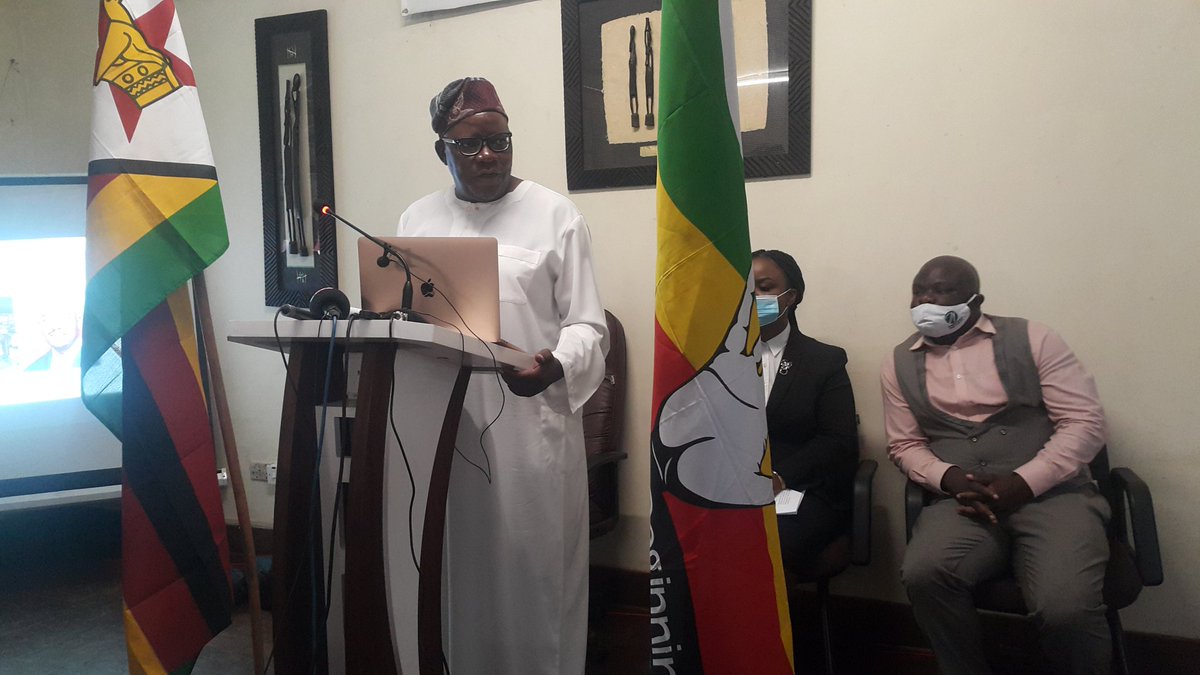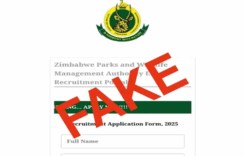Opposition MDC Alliance vice president and former finance minister Tendai Biti gave an online speech on corruption in Zimbabwe on July 18, 2021.
Here, we check key claims from Biti’s address:
CLAIM: Zimbabwe is ranked 160 out of 180 on the Transparency International (TI) Corruption Perception Index
VERDICT: TRUE
“We are now ranked, by Transparency International, number 160 out of 180. We are the 20th most corrupt country in the world. We have overtaken countries that have been traditionally associated with extraction, such as Nigeria,” Biti said.
While TI has ranked Zimbabwe 157 out of 180 on its index in the last two years – 2019 and 2020, it is true that Zimbabwe overtook Nigeria in 2007 and has consistently fared worse in the corruption perception stakes since then.
CLAIM: Zimbabwe has lost US$14 billion through the Ministry of Finance
VERDICT: INCORRECT
Biti said: “We know from the audited statements of the Auditor General that US$2,7 billion was stolen and lost directly through Treasury in 2017, US$3,5 billion was lost directly through Treasury in 2018 and the recently released audit report of 2019 shows a loss of US$7.6 billion lost through Treasury. So, in three years, over and above the budget deficit, around US$14 billion has been lost through the Ministry of Finance.”
The Auditor General, mandated to audit the financial accounts of all government ministries, departments, parastatals and local authorities, has, for several years running, voiced concern over how public finances are being managed in the country, especially by central government.
After recording fiscal surpluses between 2009 and 2011, under Biti’s stewardship of the national purse, Zimbabwe ran up budget deficits which widened from US$9,5 million in 2012 to US$2 billion in 2018. The funding gap was widest in 2017, when it was recorded at US$2,6 billion, or 8% of GDP.
The excess expenditure has seen the Ministry of Finance ballooning the unallocated reserves in the national budget. These are funds set aside to meet any unexpected expenses that might arise during the fiscal year.
In 2017, the Auditor General found that government had increased the unallocated reserves from US$31,52 million to US$3 billion.
“They (unallocated reserves) were increased to $3 019 137 531 through issuance of Treasury Bills and the URs were being disbursed to line Ministries,” the Auditor General reported.
Although the ministry provided the auditors with a schedule of how the unallocated reserve funds were distributed across ministries, government departments and commissions, the Auditor General noted differences in funds allocated and those accounted for by the various recipients.
“However, as at May 10, 2018 line Ministries had confirmed receipt of disbursements from Unallocated Reserves amounting to $637 010 651 giving a variance of $2 382 126 880.”
The Auditor General does not, however, make a finding that these funds were stolen.
Nor does the Biti-led Public Accounts Committee(PAC), which tackled the matter in 2019.
A report tabled by the PAC in parliament only goes so far as to rap the finance minister for failing “to present in the National Assembly, additional or supplementary estimates of expenditure and additional or supplementary bills.”
The PAC directed Treasury to seek Parliament’s pardon for unauthorised and excess expenditure.
For 2018, the Auditor General similarly found that the government, through the finance ministry, had overspent by US$3,2 billion. The Auditor General said the excess expenditure “was mainly related to Unallocated Reserves transferred to Ministries” by Treasury.
Unlike the 2017 accounts, the 2018 unallocated reserve distribution figures provided by Treasury and government departments largely matched.
Again, while her report flagged risks associated with excess expenditure, the Auditor General did not make a finding that the US$3.2 billion had been lost or stolen.
The latest Auditor General’s report, for 2019, also flagged excess expenditure, which also arose from unallocated reserves distributed to ministries.
Zimbabwe officially reintroduced its local currency in February 2019 and its budget for that year has been restated in Zimbabwean dollars.
The unallocated reserves for that year, ZW$7.4 billion, were stated in local currency, not United States dollars.
There is, therefore, no evidence in the Auditor General’s reports cited by Biti, of US$14 billion, equivalent to 67% of the country’s GDP, having been “stolen and lost” through the finance ministry between 2017 and 2019.
CLAIM: 79% our people are living in extreme poverty, surviving on less than US$1,25 a day.
VERDICT: EXAGGERATED
A World Bank report released in June 2021 put the number of extremely poor Zimbabweans at 7,9 million, or 49% of the population.
“In 2020, the pandemic and its impacts disrupted livelihoods, especially in urban areas, and added 1.3 million Zimbabweans to the extreme poor. Estimates suggest the number of extreme poor reached 7.9 million—almost 49 percent of the population,” the report reads.
This was an increase from 38% reported by the official Zimbabwe National Statistics Agency (Zimstat) in its 2019 Poverty, Income Consumption and Expenditure Survey (PICES).
Zimstat conducts the PICES survey every five years and the next one was due in 2022. However, the exceptional circumstances of 2019 compelled the agency, which partners World Bank technical staff on the surveys, to conduct one that year following Zimbabwe’s devastating drought and an inflation spike triggered by the reintroduction of a local currency.
Zimstat simulations for the subsequent period showed extreme poverty levels to have risen to 52% by the end of 2019, in line with the World Bank estimates for 2020.
CLAIM: Our infant mortality rates are now 102 out of a thousand.
VERDICT: UNTRUE
UNICEF defines infant mortality as the probability of a child dying between birth and one year of age, expressed per 1,000 live births.
According to the latest available UNICEF data, Zimbabwe’s infant mortality rate was 38.4 deaths for every 1,000 live births, the lowest it has been since 1970.
Zimstat’s 2019 Multiple Indicator Cluster Survey puts the country’s infant mortality rate at 53 deaths per 1,000 live births.
CLAIM: There is no economy that has involuntarily dollarised, that has been able to de-dollarise.
VERDICT: INCORRECT
Although economists broadly acknowledge that the process of undoing dollarisation – the use of foreign currencies as a medium of exchange, store of value, or unit of account – is difficult, the IMF says there are a few economies that have achieved this feat.
An IMF staff team that produced a 2015 report on dollarisation in sub-Saharan Africa concedes this difficulty, but lists 11 countries which de-dollarised between 2001 and 2012.
“While many countries have attempted to de-dollarize, only a few have succeeded in these efforts. Among them, Israel, Poland, Bolivia, and Peru provide a good illustration of the comprehensive policy package needed to reduce financial dollarization,” the staff team reported.
“Out of 194 countries for which data are available, 42 were initially dollarized (of which nine in sub-Saharan Africa); out of these, 11 countries were successful and de-dollarized; and the remaining 31 countries were unsuccessful and remained dollarized.”
CLAIM: The average civil servant used to earn US$500 during the time of the GNU, he is now earning US$35-40.
VERDICT: INCORRECT
Information compiled by the International Labour Organisation from the National Joint Negotiating Council (NJNC), the platform for government workers’ wage negotiations, shows that, at end of the government of national unity mid-2013, the lowest paid civil servant was getting a monthly wage of US$296, made up of US$159 basic pay, US$63 transport allowance and US$74 housing allowance.
The lowest paid teacher was earning a basic salary of US$230, plus US$189 housing and transport allowances, amounting to a total package of US$419. Teachers make up the bulk of the civil service.
A January 2014 pay increase saw the least paid civil servant getting a total package of US$375, while entry-level teachers were now on US$500.
According to a March 12, 2021 circular by the Zimbabwe Confederation of Public Sector Trade Unions (ZCPSTU), the main civil servants’ union, government wages were ranging from ZW$14,652 to ZW$28,168.
This was ahead of an April 1 wage increase, which would see the least paid earning ZW$16,752 (US$195 at the official exchange rate or US$124 on the black market), with the highest band getting ZW$33,647 (US$391 at the official rate or US$249 on the parallel market).
CLAIM: If Zimbabwe were to import ethanol from Brazil, the United States of America or Scandinavian countries, it would land FOB at US$0.50. But we are paying a premium to Billy Rautenbach of US$1.10 to US$1.20.
VERDICT: INCORRECT
A litre of ethanol was quoted at US$0.69 in Brazil and between US$0.60 and US$0.63 per litre, free on board, according to the US Grains Council’s data for July 21, 2021. Shipping ethanol to Zimbabwe from abroad would add freight and insurance costs to the final price.
In Zimbabwe, ethanol for blending with petrol is priced at US$1.10 per litre, according to energy regulator ZERA.
When the matter of ethanol pricing came up for discussion in Parliament in 2018, amid charges that local ethanol was overpriced, the then ZERA head, Gloria Magombo argued that it did not make economic sense to import the product.
Do you want to use our content? Click Here












